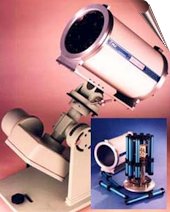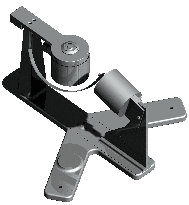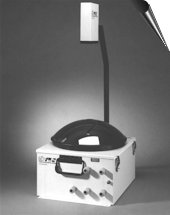High Voltage / Piezo Amplifiers & Signal Conditioners
Fiber Optic Links / Data Acquisition Systems
RF Power Amplifiers / Dual Directional Couplers
Instruments for Biological Science
Under Water Metal Detectors, Camera’s & Sonar Systems
|
UV Radiometry

Ultraviolet Multifilter Rotating Shadowband Radiometer: UVMFR-7
Pyranometers: UVB-1, UVA-1

|
The UVB-1 and UVA-1 Pyranometers measure total irradiance from 280 to 320 nm and 320 to 400 nm, respectively. The instruments produce a high level 0-4 VDC output signal and are thermally stabilized for long term reference-grade measurements. The UVB-1 is field proven in networks throughout the world. Solar dose modeling software, UV-Calc, is included with the instrument. The UVPS power supply (shown) or the YESDAS-2 datalogger are available as accessories.
Datasheet:  PDF PDF
|
Sun Photometer: SPUV-6/10

|
The SPUV Sun Photometer measures direct normal solar irradiance at up to ten narrowband wavelengths from 300 in the UV-B through 1020 nm in the near-IR, and is the world's most advanced commercial solar sun photometer. Thermally stabilized, environmentally sealed state-of-the-art interference filters, with energy-absorbing visible pre-filters on UV channels provide long term calibration stability. Instead of using a rotating filter wheel, it makes measurements simultaneously across all channels meeting the Baseline Solar Radiation Network's requirements for atmospheric turbidity measurements. A modular mechanical design permits rapid channel service. The SPUV mounts on most solar trackers (shown here mounted on the ST-1). The SPUV system includes the YESDAS-2 datalogger and works with YESDAS Manager data analysis software.
Datasheet:  PDF PDF
|
Atmoshpheric Radiation Monitoring System
Multifilter Rotating Shadowband Radiometer: MFR-7

|
The Multifilter Rotating Shadowband Radiometer (MFR-7) measures total, diffuse, and direct irradiance at six wavelengths (415, 500, 615, 673, 870, and 940 nm, each 10 nm FWHM) in the visible/NIR, and includes one unfiltered broad-band silicon pyranometer. Thermally stabilized, environmentally sealed state-of-the-art interference filters provide excellent long term calibration stability. Instead of using a rotating filter wheels the MFR-7 makes measurements simultaneously across all seven channels, meeting the Baseline Solar Radiation Network's requirements for atmospheric turbidity measurements. The shadowband enables the instrument to measure all three components of solar irradiance with one detector. The MFR-7 system includes the YESDAS-2 datalogger and works with YESDAS Manager data analysis software. The UVMFR, a shadowband instrument for the UV region, is also available
Datasheet:  PDF PDF
|

|
Single Detector Rotating Shadowband Radiometer: SDR-1

|
The SDR-1 Single Detector Rotating Shadowband Radiometer is identical to our standard Multifilter Rotating Shadowband Radiometer (MFR-7) except that it has a single cosine-corrected broadband silicon channel that provides fully automatic measurements of global, diffuse, and direct normal components of solar radiation. It is very similar to bolometric/thermopile type radiometers except the spectral response of silicon does not extend as far into the mid infrared. Historically, a total solar pyranometer has been integrated with a solar tracker-mounted normal incidence pyrheliometer and a third shaded pyranometer to make these measurements, as is done in the Baseline Solar Radiation Network. However, the SDR-1 offers a simpler and less expensive alternative than these separate instruments. Because it uses only one detector to make all three measurements, there is only one calibration necessary. In addition, because it uses only one mechanical axis of rotation it tends to stay in alignment with the sun much better than a two axis tracker, reducing labor required to operate the system.
Datasheet:  PDF PDF
|
Total Solar Pyranometer: TSP-400

|
The Model TSP-400 Total Solar Pyranometer is a precision meteorological instrument that measures global (direct and diffuse) total solar radiation. Like the other members of the YES Total Solar Pyranometer family, it is ruggedly designed for long-term field use. The Model TSP-400V adds a ventilation system for increased accuracy under all ambient temperature conditions. When properly characterized, the Model TSP-400V meets or exceeds the requirements for a World Meteorological Organization high class pyranometer (formerly called a secondary standard).
Datasheet:  PDF PDF
|
Total Solar Pyranometer: TSP-700

|
The state-of-the-art TSP-700 Total Solar Pyranometer uses platinum resistance thermometers to make high accuracy broadband irradiance measurements and replace older thermopile measurement technology. The instrument offers an excellent cosine response and a high level output signal that is totally independent of ambient temperature changes. When properly characterized, the ventilated TSP-700 meets the requirements for a World Meteorological Organization high class pyranometer (formerly called a secondary standard). YES Models TSP-400 and TSP-100 offer lower cost alternatives for applications that do not require the precision of the TSP-700.
Datasheet:  PDF PDF
|
Total Infrared Radiometer: TIR-570

|
The Model TIR-570 Total Infrared Radiometer represents the state-of-the-art for making precise field measurements of downwelling broadband atmospheric infrared irradiance. The TIR-570 uses a advanced chopped pyroelectric detector and precision interference filter integrated with a self-contained black body source to measure spectral irradiance from 4 to 30 μm. Global climate change researchers now have a tool for routine high accuracy atmospheric IR measurements.
Datasheet:  PDF PDF
|
All Specifications are subject to change without a Prior Notice
For any sort of clarifications kindly contact:
info@globesolutionz.com
|